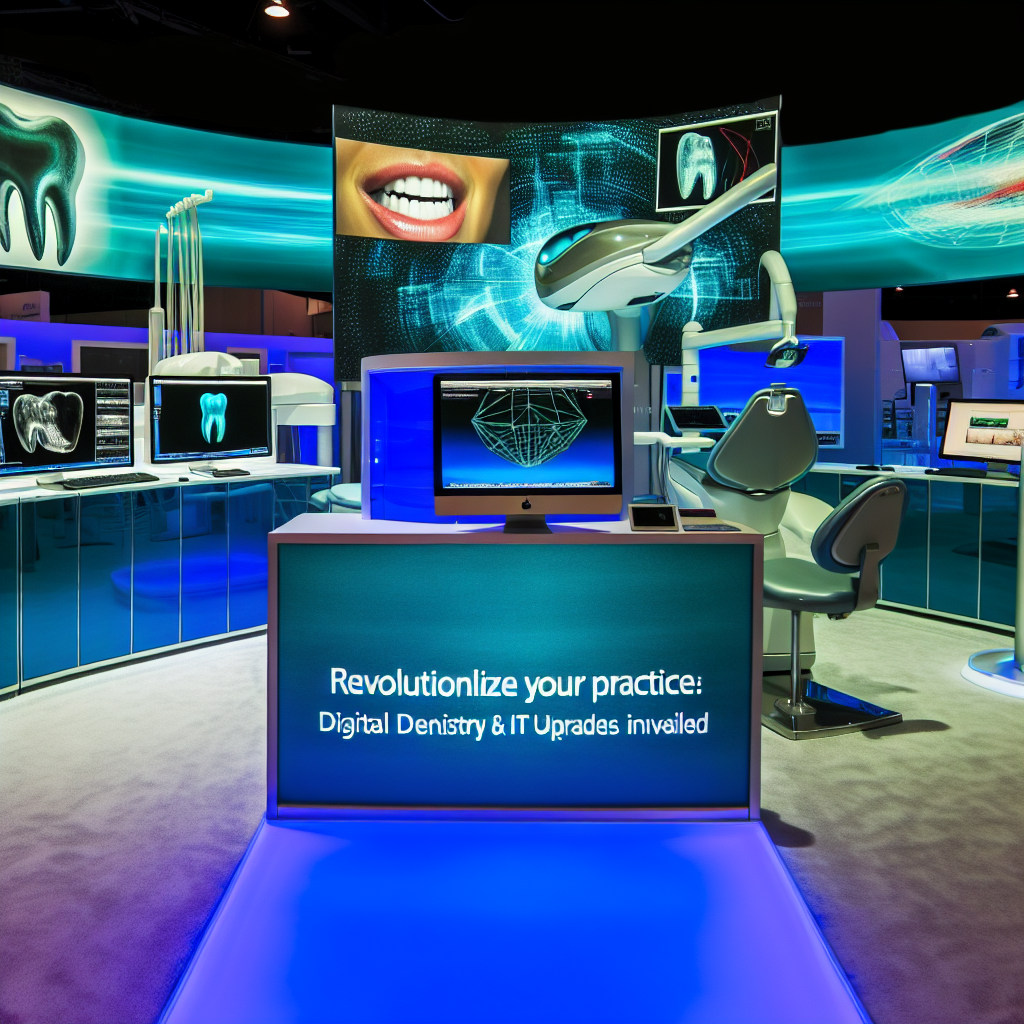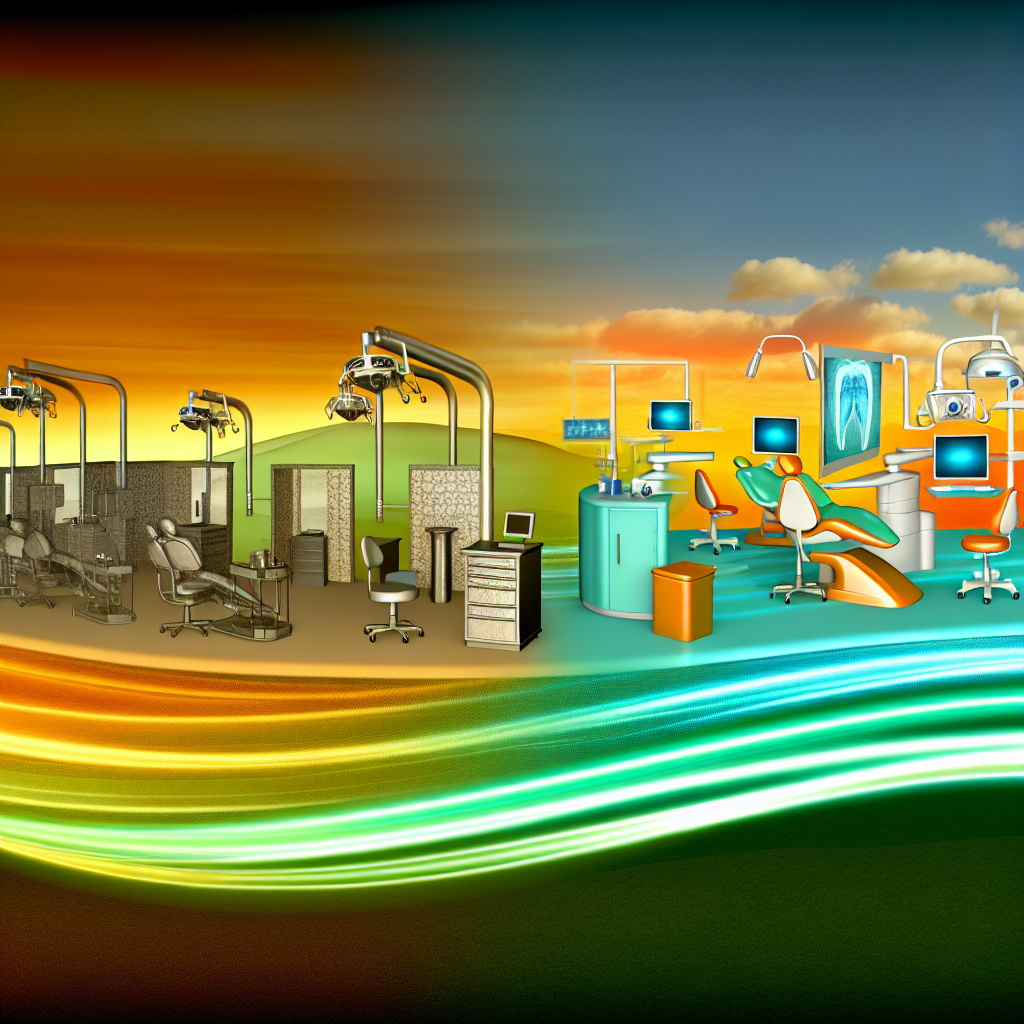Digital Dentistry: Transforming Patient Care with Advanced Dental Technology
In recent years, the field of dentistry has witnessed a remarkable transformation, driven by the integration of advanced dental technology and modern IT strategies. This evolution, often referred to as digital dentistry, is reshaping patient care by enhancing diagnostic accuracy, improving treatment outcomes, and streamlining practice management. As dental professionals increasingly adopt these innovations, the landscape of dental care is becoming more efficient and patient-centered.
One of the most significant advancements in digital dentistry is the use of digital imaging technologies. Traditional X-rays, while still in use, are gradually being supplemented or replaced by digital radiography. This technology not only reduces radiation exposure for patients but also provides immediate, high-resolution images that can be easily shared and analyzed. Furthermore, the integration of 3D imaging, such as cone beam computed tomography (CBCT), allows for more precise diagnosis and treatment planning, particularly in complex cases involving implants or orthodontics.
In addition to imaging, computer-aided design and computer-aided manufacturing (CAD/CAM) systems are revolutionizing restorative dentistry. These systems enable the creation of highly accurate dental restorations, such as crowns, bridges, and veneers, in a fraction of the time required by traditional methods. By utilizing digital impressions and in-office milling machines, dental practitioners can offer same-day restorations, significantly reducing the number of visits required for patients and enhancing their overall experience.
Moreover, the advent of digital workflows in dental practices is streamlining operations and improving patient management. Electronic health records (EHRs) have become a cornerstone of modern dental practices, allowing for seamless access to patient information, treatment history, and appointment scheduling. This not only enhances communication between dental professionals and patients but also facilitates collaboration among multidisciplinary teams, ensuring comprehensive care.
Tele-dentistry is another emerging trend that is expanding access to dental care, particularly in underserved areas. By leveraging video conferencing and secure data sharing, dental professionals can provide consultations, follow-ups, and even certain diagnostic services remotely. This approach not only increases convenience for patients but also helps bridge the gap in access to care for those in rural or remote locations.
Furthermore, the integration of artificial intelligence (AI) in dental practices is beginning to show promise in enhancing diagnostic capabilities and treatment planning. AI algorithms can analyze vast amounts of data from digital images and patient records to identify patterns and predict outcomes, assisting dental professionals in making more informed decisions. As AI technology continues to evolve, its potential applications in dentistry are likely to expand, offering new opportunities for improving patient care.
While the benefits of digital dentistry are evident, the adoption of these technologies also presents challenges. Dental professionals must invest in training and education to effectively utilize new tools and systems. Additionally, ensuring data security and patient privacy is paramount, as the increased reliance on digital records and communication channels heightens the risk of cyber threats.
In conclusion, the integration of advanced dental technology and modern IT strategies is transforming the field of dentistry, offering numerous benefits for both practitioners and patients. As digital dentistry continues to evolve, it holds the promise of more accurate diagnostics, efficient treatments, and improved patient experiences. By embracing these innovations, dental professionals can enhance the quality of care they provide, ultimately leading to better oral health outcomes for their patients.
Enhancing Practice Security: Modern IT Strategies for Dental Offices
In the rapidly evolving landscape of dental technology, ensuring the security of patient data has become a paramount concern for dental practices. As digital records and electronic health systems become more prevalent, the need for robust IT strategies to protect sensitive information is increasingly critical. Modern IT strategies offer a comprehensive approach to safeguarding dental practices against potential security threats, ensuring that patient data remains confidential and secure.
One of the primary considerations in enhancing practice security is the implementation of advanced encryption methods. Encryption serves as a fundamental layer of defense, converting sensitive data into a coded format that is unreadable without the appropriate decryption key. By employing strong encryption protocols, dental practices can protect patient information from unauthorized access, even if data breaches occur. This is particularly important as cyber threats become more sophisticated, targeting vulnerabilities in digital systems.
In addition to encryption, dental practices must prioritize the regular updating and patching of their software systems. Outdated software can present significant security risks, as cybercriminals often exploit known vulnerabilities in older versions. By maintaining up-to-date software, dental offices can mitigate these risks and ensure that their systems are equipped with the latest security features. Regular updates not only enhance security but also improve the overall functionality and efficiency of the practice’s IT infrastructure.
Furthermore, implementing a robust firewall system is essential for protecting dental practices from external threats. Firewalls act as a barrier between the internal network and potential threats from the internet, monitoring and controlling incoming and outgoing network traffic. By configuring firewalls to block unauthorized access and suspicious activity, dental practices can significantly reduce the risk of cyberattacks. Additionally, employing intrusion detection and prevention systems can further bolster security by identifying and responding to potential threats in real-time.
Another critical aspect of modern IT strategies is the importance of data backup and recovery solutions. In the event of a data breach or system failure, having a reliable backup system ensures that patient information can be restored quickly and efficiently. Regularly scheduled backups, stored both on-site and in secure cloud environments, provide an additional layer of protection against data loss. Moreover, testing these backup systems periodically is crucial to ensure their effectiveness and reliability in times of need.
Employee training and awareness also play a vital role in enhancing practice security. Dental staff must be educated on the importance of data security and trained to recognize potential threats, such as phishing emails or suspicious links. By fostering a culture of security awareness, dental practices can empower their employees to act as the first line of defense against cyber threats. Regular training sessions and updates on the latest security practices can help maintain a vigilant and informed workforce.
Finally, conducting regular security audits and assessments is essential for identifying potential vulnerabilities within a dental practice’s IT infrastructure. These audits provide valuable insights into the effectiveness of current security measures and highlight areas for improvement. By proactively addressing identified weaknesses, dental practices can strengthen their defenses and ensure compliance with industry regulations and standards.
In conclusion, modern IT strategies are indispensable for enhancing the security of dental practices. Through the implementation of advanced encryption, regular software updates, robust firewalls, reliable backup solutions, employee training, and comprehensive security audits, dental offices can protect sensitive patient data from the ever-present threat of cyberattacks. As technology continues to advance, staying informed and proactive in adopting these strategies will be crucial for maintaining the integrity and confidentiality of patient information.
The Future of Dental Compliance: Navigating Regulations with IT Upgrades
In the rapidly evolving landscape of dental care, compliance with regulations is becoming increasingly complex. As dental practices strive to maintain high standards of patient care, they must also navigate a labyrinth of regulatory requirements. The integration of modern IT strategies into dental technology offers a promising pathway to streamline compliance processes, ensuring that practices not only meet but exceed regulatory expectations. This intersection of technology and compliance is reshaping the future of dental care, providing both challenges and opportunities for practitioners.
To begin with, the regulatory environment in the dental industry is multifaceted, encompassing patient privacy laws, data protection regulations, and clinical standards. The Health Insurance Portability and Accountability Act (HIPAA) in the United States, for instance, mandates stringent safeguards for patient information. Non-compliance can result in severe penalties, making it imperative for dental practices to adopt robust compliance strategies. Here, modern IT solutions play a crucial role. By leveraging advanced software systems, dental practices can automate many compliance-related tasks, reducing the risk of human error and ensuring that all regulatory requirements are consistently met.
Moreover, the adoption of electronic health records (EHRs) has revolutionized the way dental practices manage patient information. EHRs not only enhance the efficiency of data management but also facilitate compliance by providing secure, centralized access to patient records. This digital transformation allows for real-time updates and seamless sharing of information across authorized personnel, thereby improving the accuracy and reliability of patient data. Furthermore, EHR systems are often equipped with built-in compliance checks, alerting practitioners to potential issues before they escalate into violations.
In addition to EHRs, cloud computing is another technological advancement that is transforming dental compliance. By migrating data to the cloud, dental practices can ensure that their information is stored securely and is easily accessible from any location. This flexibility is particularly beneficial in the context of compliance, as it allows for continuous monitoring and auditing of data. Cloud-based solutions also offer scalable storage options, enabling practices to efficiently manage large volumes of data without compromising on security or compliance.
However, the integration of IT solutions into dental practices is not without its challenges. One of the primary concerns is cybersecurity. As dental practices become increasingly reliant on digital systems, they must also contend with the growing threat of cyberattacks. Implementing robust cybersecurity measures is essential to protect sensitive patient information and maintain compliance with data protection regulations. This includes deploying firewalls, encryption technologies, and regular security audits to identify and mitigate potential vulnerabilities.
Furthermore, the successful implementation of IT solutions requires a cultural shift within dental practices. Staff must be adequately trained to use new technologies and understand their role in maintaining compliance. This involves not only technical training but also fostering a compliance-oriented mindset among all team members. By promoting a culture of compliance, dental practices can ensure that their IT strategies are effectively aligned with regulatory requirements.
In conclusion, the future of dental compliance is inextricably linked to the adoption of modern IT strategies. By embracing technological advancements such as EHRs and cloud computing, dental practices can streamline compliance processes, enhance data security, and ultimately improve patient care. While challenges remain, particularly in the realm of cybersecurity, the potential benefits of integrating IT solutions into dental practices are significant. As the regulatory landscape continues to evolve, those practices that proactively adopt these technologies will be well-positioned to navigate the complexities of compliance and thrive in the modern dental industry.
Cloud Integration in Dental Practices: Streamlining Operations with Dental Software
In the rapidly evolving landscape of dental practices, the integration of cloud technology has emerged as a pivotal strategy for streamlining operations and enhancing patient care. As dental professionals increasingly recognize the benefits of digital transformation, cloud-based dental software solutions are becoming indispensable tools in modern practice management. These solutions offer a myriad of advantages, from improved data accessibility to enhanced security measures, thereby revolutionizing the way dental practices operate.
One of the primary benefits of cloud integration in dental practices is the ability to access patient data and practice management tools from virtually anywhere. This flexibility is particularly advantageous for multi-location practices or for dental professionals who need to access information remotely. By storing data in the cloud, dental practices can ensure that patient records, appointment schedules, and billing information are readily available to authorized personnel, regardless of their physical location. This not only enhances operational efficiency but also facilitates better coordination among team members, ultimately leading to improved patient care.
Moreover, cloud-based dental software solutions offer robust data security features that are crucial in safeguarding sensitive patient information. With the increasing prevalence of cyber threats, dental practices must prioritize data protection to maintain patient trust and comply with regulatory requirements such as the Health Insurance Portability and Accountability Act (HIPAA). Cloud providers typically employ advanced encryption methods, regular security updates, and comprehensive backup systems to protect data from unauthorized access and potential breaches. Consequently, dental practices can mitigate the risks associated with data loss or theft, ensuring that patient information remains confidential and secure.
In addition to enhancing data accessibility and security, cloud integration also streamlines administrative tasks, allowing dental professionals to focus more on patient care. Automated features such as appointment reminders, billing processes, and inventory management reduce the burden of manual tasks, thereby increasing productivity and reducing the likelihood of human error. For instance, automated appointment reminders can significantly decrease no-show rates, while streamlined billing processes can expedite payment collections and improve cash flow. By optimizing these administrative functions, dental practices can allocate more resources to patient-centered activities, ultimately enhancing the overall patient experience.
Furthermore, cloud-based solutions facilitate seamless collaboration and communication within dental teams. With centralized data storage, team members can easily share information and collaborate on treatment plans, ensuring that all parties are informed and aligned. This collaborative approach not only improves treatment outcomes but also fosters a more cohesive and efficient working environment. Additionally, cloud integration supports telehealth services, enabling dental professionals to conduct virtual consultations and follow-ups, thereby expanding access to care and accommodating patients’ needs more effectively.
As dental practices continue to embrace digital transformation, the integration of cloud technology will undoubtedly play a crucial role in shaping the future of dental care. By leveraging cloud-based dental software solutions, practices can enhance operational efficiency, improve data security, and deliver superior patient care. As a result, dental professionals can remain competitive in an increasingly digital world, ensuring that they meet the evolving needs of their patients while maintaining the highest standards of care. In conclusion, cloud integration represents a strategic investment for dental practices seeking to optimize their operations and thrive in the modern healthcare landscape.
Maximizing Efficiency: The Role of IT Upgrades in Modern Dental Technology
In the rapidly evolving landscape of dental technology, the integration of modern IT strategies has become indispensable for maximizing efficiency and enhancing patient care. As dental practices strive to keep pace with technological advancements, the role of IT upgrades cannot be overstated. These upgrades not only streamline operations but also ensure that dental professionals can deliver the highest standard of care to their patients.
To begin with, the adoption of electronic health records (EHRs) has revolutionized the way dental practices manage patient information. By transitioning from paper-based records to digital systems, dental offices can significantly reduce the time spent on administrative tasks. This shift allows dental professionals to focus more on patient care rather than paperwork. Moreover, EHRs facilitate seamless communication between different healthcare providers, ensuring that patient information is accurate and up-to-date. This interconnectedness is crucial for providing comprehensive care, as it enables dentists to make informed decisions based on a complete view of a patient’s medical history.
In addition to EHRs, the implementation of advanced imaging technologies has transformed diagnostic processes in dental practices. Digital radiography, for instance, offers numerous advantages over traditional film-based methods. It not only reduces radiation exposure for patients but also provides instant access to high-quality images. This immediacy allows for quicker diagnosis and treatment planning, ultimately improving patient outcomes. Furthermore, digital images can be easily shared with specialists for consultation, fostering a collaborative approach to patient care.
Another critical aspect of IT upgrades in dental technology is the enhancement of practice management software. Modern software solutions offer a comprehensive suite of tools designed to optimize various aspects of practice operations. From appointment scheduling and billing to inventory management and patient communication, these systems streamline workflows and reduce the likelihood of errors. By automating routine tasks, dental practices can operate more efficiently, allowing staff to dedicate more time to patient interactions and care.
Moreover, the integration of cloud-based solutions has further expanded the capabilities of dental IT systems. Cloud technology offers several benefits, including data security, scalability, and remote access. With patient data stored securely in the cloud, dental practices can protect sensitive information from potential breaches while ensuring compliance with regulatory standards. Additionally, cloud-based systems allow for easy scalability, enabling practices to adapt to changing needs without significant infrastructure investments. The ability to access data remotely also supports telehealth initiatives, providing patients with greater flexibility in receiving care.
Furthermore, the role of cybersecurity in dental IT cannot be overlooked. As dental practices become increasingly reliant on digital systems, the risk of cyber threats grows. Implementing robust cybersecurity measures is essential to safeguarding patient data and maintaining trust. Regular software updates, employee training, and the use of encryption technologies are vital components of a comprehensive cybersecurity strategy.
In conclusion, the integration of modern IT strategies in dental technology is pivotal for maximizing efficiency and enhancing patient care. By embracing IT upgrades such as electronic health records, advanced imaging technologies, practice management software, and cloud-based solutions, dental practices can streamline operations and improve patient outcomes. As the dental industry continues to evolve, staying abreast of technological advancements and prioritizing cybersecurity will be crucial for maintaining a competitive edge and delivering exceptional care.
Unlock the future of your dental practice with cutting-edge technology and modern IT strategies. Discover more at Dental IT Insights. Learn more.











